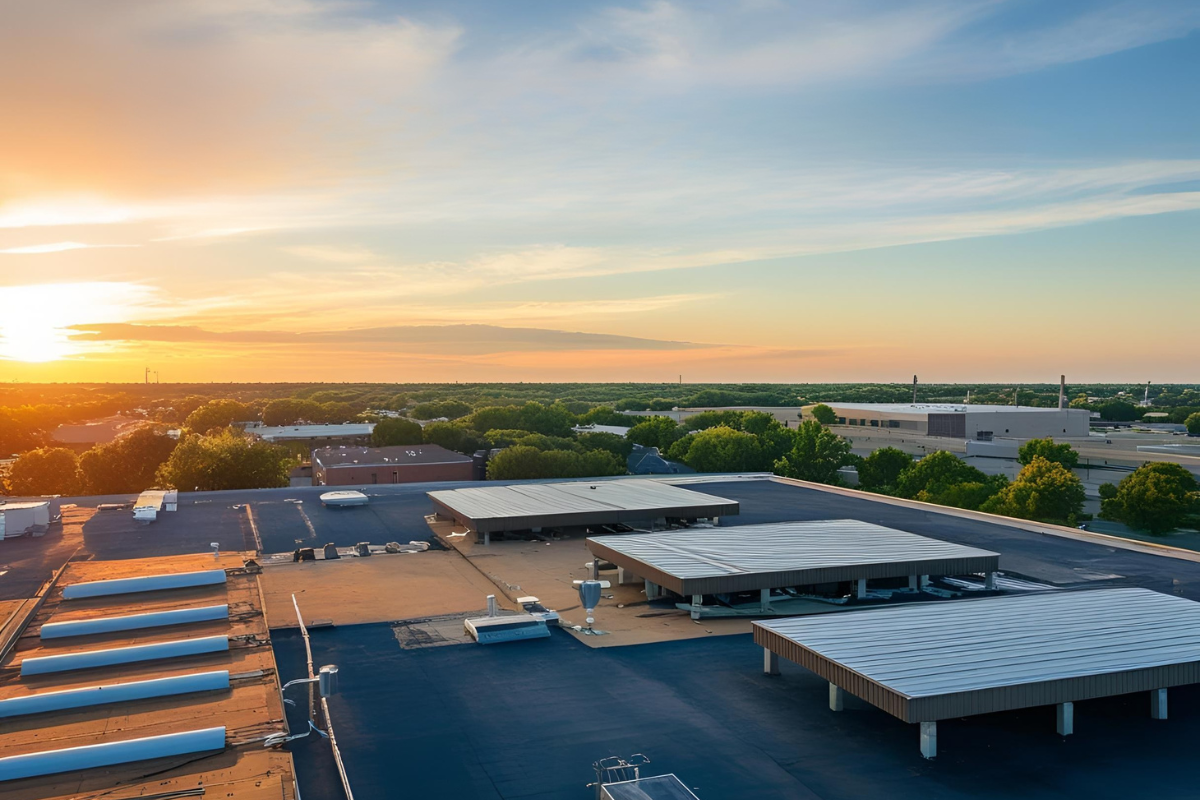In Wichita, Kansas, where summers sizzle and winters bite, energy costs can significantly impact a commercial building’s bottom line. While many factors contribute to a building’s energy consumption, the roof plays a crucial role. A well-designed, energy-efficient commercial roof can significantly reduce heating and cooling costs, creating a more comfortable environment for employees and customers while minimizing the building’s environmental footprint.
This article explores the connection between roofing and energy efficiency, and highlights how certain roofing materials and technologies can help Wichita businesses save on energy costs.
The Roof’s Role in Energy Efficiency
A commercial roof directly influences a building’s energy performance in several ways:
- Solar Heat Gain: During hot summer months, the roof absorbs solar radiation, transferring heat into the building’s interior. This increases the demand for air conditioning, leading to higher energy consumption.
- Heat Loss: In winter, a poorly insulated roof can allow heat to escape, forcing heating systems to work harder to maintain a comfortable temperature.
- Air Leakage: Leaks and gaps in the roofing system can contribute to air infiltration, further increasing energy consumption.
Roofing Materials and Technologies for Energy Efficiency
Several roofing materials and technologies can significantly improve a commercial building’s energy efficiency:
- Reflective Roofing Materials:
- “Cool roofs” are designed to reflect sunlight and absorb less heat. These roofs are typically made from materials with high reflectivity, such as white or light-colored coatings, metal roofing, or specialized reflective membranes.
- By reducing solar heat gain, cool roofs can significantly lower cooling costs, especially during Wichita’s hot summers.
- These roofs also help to mitigate the urban heat island effect, which contributes to higher temperatures in urban areas.
- Insulation:
- Adequate insulation is crucial for minimizing heat transfer through the roof.
- Spray foam insulation, rigid board insulation, and other insulation materials can be installed to improve the roof’s thermal performance.
- Proper insulation can reduce both heating and cooling costs, creating a more comfortable and energy-efficient building.
- Single-Ply Membranes (TPO and PVC):
- Thermoplastic olefin (TPO) and polyvinyl chloride (PVC) single-ply membranes are popular choices for flat or low-slope commercial roofs.
- These membranes are available in white or light colors, offering excellent reflectivity.
- They are also durable, weather-resistant, and relatively easy to install.
- Green Roofs:
- Green roofs, also known as vegetated roofs, are covered with plants and vegetation.
- They provide excellent insulation, reduce stormwater runoff, and improve air quality.
- Green roofs can also contribute to a more aesthetically pleasing environment.
- While more costly to install, they provide an excellent return on investment over time.
- Photovoltaic (PV) Systems:
- Solar panels can be installed on commercial roofs to generate electricity.
- This can significantly reduce energy costs and contribute to a more sustainable energy future.
- PV systems are particularly effective on large, flat roofs with ample sunlight exposure.
Benefits of an Energy-Efficient Roof
Investing in an energy-efficient roof offers numerous benefits for Wichita businesses:
- Reduced Energy Costs: Lower heating and cooling costs translate to significant savings on utility bills.
- Improved Comfort: A well-insulated roof helps to maintain a consistent and comfortable indoor temperature.
- Environmental Sustainability: Reducing energy consumption minimizes the building’s carbon footprint and contributes to a more sustainable environment.
- Increased Property Value: An energy-efficient building is more attractive to potential buyers or tenants.
- Extended Roof Lifespan: Some energy efficient roofing systems like metal, are very durable, and extend the life of your roof.
- Potential Tax Incentives: Many government and local programs offer tax credits and rebates for energy-efficient building improvements.
Choosing the Right Roofing System
Selecting the right roofing system for your Wichita commercial building depends on several factors, including:
- Building Type and Design: The shape and slope of your roof will influence the choice of roofing materials.
- Budget: Consider the initial cost of materials and installation, as well as the long-term energy savings.
- Climate: Choose materials that are suitable for Wichita’s climate, including its hot summers and cold winters.
- Energy Efficiency Goals: Determine your specific energy efficiency goals and choose materials that align with those goals.
Partnering with Solid Rock Commercial Roofing
Solid Rock Commercial Roofing understands the importance of energy efficiency for Wichita businesses. Our team of experts can assess your building’s specific needs and recommend the most suitable roofing materials and technologies to maximize energy savings. We provide high-quality installation and maintenance services, ensuring that your roof performs optimally for years to come.
By investing in an energy-efficient roof, Wichita businesses can save money, improve comfort, and contribute to a more sustainable future. Contact Solid Rock Commercial Roofing today to learn more about our energy-efficient roofing solutions.




